PERIKLES (c. 490–429 BC) Ancient Greek politician, strategist...

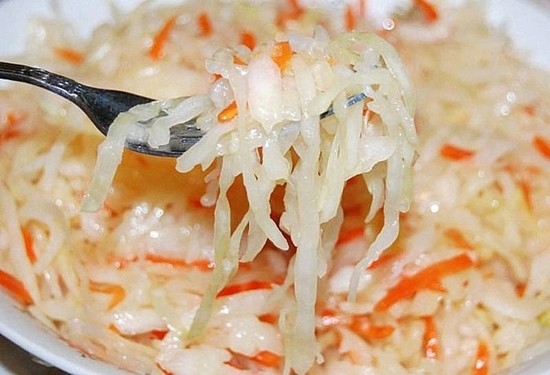
With your own hands, you can cook a variety of dishes, both simple and complex. You just need to stick to the recipe and believe in yourself. So an excellent find for culinary experiments will be preparations for the winter. They can be prepared during the summer and autumn, and the resulting dishes will delight relatives and friends for more than one month. One of the most useful preparations is sauerkraut. Recently, we have already talked about how sauerkraut is prepared in own juice. Today, let's clarify what other sauerkraut recipes for the winter in jars can help prepare it for future use.
Cabbage recipes for the winter ready in three days
Delicious sauerkraut in jars for the winter
To prepare such a blank, you need to prepare a three-kilogram head of cabbage, one large carrot, salt and sugar.
Cabbage should be white and sweet. After all, if the vegetable is bitter, it can spoil the taste of ready-made sauerkraut. Shred the cabbage.
Peel the carrots and grate on a grater.
Add a tablespoon of salt and a couple of tablespoons of sugar to the vegetables. Salt use the most common, not iodized.
It is convenient to put vegetables in a large bowl or just on the table. Mix them well with salt and knead with your hands, as if kneading dough. Do not be afraid to mash the cabbage, it will still turn out crispy and very tasty.
Then send the prepared vegetables to the jar and tamp them well with a wooden rocking chair.
The cabbage will give juice, and it should be enough to cover the contents of the jar completely. As the fermentation process begins, the juice may start to run out the top, so place the jar in a bowl. Fermentation is accompanied by the release of carbon dioxide in the form of air bubbles. By the way, sauerkraut juice is very useful.
Leave the cabbage in the room. It should stand with you at room temperature for three days, after which it can be transferred to the refrigerator or to the balcony, or to the cellar. If cooked cabbage is a bit bitter, try bringing it into the room at night.
Such a blank can be freely stored for several months.
How to cook sauerkraut in a jar of brine?
To prepare this version of sauerkraut, you need to stock up on two and a half kilograms of cabbage, large carrots, salt, sugar, five peas of allspice, a couple of bay leaves.
First of all, prepare the brine: boil one and a half liters of water, dip a couple of tablespoons of salt and a couple of tablespoons of sugar into it. Mix well. After that, put allspice and bay leaf in the brine and leave to cool.
During this time, prepare the cabbage: chop it smaller. Peel the carrots and grate on a grater. Stir the vegetables together, but do not crush them.
Fold the cabbage with carrots in a jar, not tamping much. After filling it with brine at room temperature.
Leave the cabbage at room temperature for three days, pierce it from time to time with a wooden skewer to let the air out. Do not forget that it is best to put the jar in a bowl; during fermentation, about half a liter of water can flow out of it.
Store cooked cabbage refrigerated.
How to cook sauerkraut in a jar using water?
To prepare this version of the preparation, use a cabbage head weighing about three kilograms, a medium carrot, salt, ordinary water at room temperature and honey.
Chop up the cabbage and grate the carrots. Mix well, add a tablespoon of salt and mix. Don't crush the vegetables too much.
Put them in a jar, tamping with a wooden pestle, but not too hard. Pour the cabbage with six hundred to eight hundred milliliters of water and leave at room temperature.
After the cabbage begins to ferment well (usually this happens on the second day), completely drain the resulting brine. To do this, dump all the cabbage into a bowl, wring it out and send it back to the jar. It is desirable that the cabbage that lay on the bottom is at the top, and vice versa. Add a tablespoon of quality honey to the drained brine. Pour cabbage with this solution and leave at room temperature for another day. Next, send the finished cabbage to the cold.
Quick recipes for sauerkraut in jars
Below are two recipes. The first allows you to spend little time for harvesting, but you will only know the result of the work when you open the jar. The second recipe does not allow you to store the workpiece for a long time, but gives a quick cooking result.
Cabbage in jars for the winter for long-term storage
To prepare this option, stock up on one medium head of cabbage, four carrots and four cloves of garlic. For the brine, you need to prepare a liter of water, one and a half tablespoons of sugar and a couple of tablespoons of salt.
First of all, prepare the brine: dissolve salt and sugar in warm boiled water.
Chop the cabbage into smaller pieces, grate the carrots on a coarse grater. Spread the prepared vegetables on the table and knead with well-washed hands. Add minced garlic to the mixture. Put cabbage in jars and fill with prepared brine.
Sterilize jars for half an hour and seal.
Georgian instant sauerkraut in a jar
To prepare this option, stock up on one cabbage, one beetroot, one carrot, a head of garlic, one hot pepper and onion (optional), as well as four to six black peppercorns.
For brine, use a liter of water, half a glass of sugar, a glass of table vinegar and a couple of tablespoons of salt.
Clean vegetables. Cut beets and carrots into strips, onions into half rings, cut cabbage into large pieces, garlic and hot peppers crumble smaller. Mix the vegetables, add pepper to them and put them in a jar.
Boil water, dissolve salt and sugar in it, pour in vinegar. Pour hot brine over cabbage. Cover the jar with a lid and leave it warm for twelve hours. Next, keep the product refrigerated.
Of course, these are not all possible recipes. If you know others delicious recipes cabbage in jars, please write them in the comments below.
Sauerkraut is a very healthy dish. It is not only consumed in its pure form, but also used as a component of salads and casseroles, soups, pies. In Rus', cabbage was fermented in wooden barrels, because it was cooked for a large family and for the future, and today it is more often done in ordinary glass jars, especially since it is impossible to store a huge barrel in an ordinary city apartment. What principles should be followed when starting sauerkraut, and how to keep it crispy and sweet?
Most often, a 3-liter jar is used for this process: this choice is also due to the size of the head (even the smallest after shredding can feed the whole family for several days), and the fact that such dishes are prepared “in reserve”, it is unreasonable to make a small portion. Therefore, below is a recipe for sauerkraut based on a 3-liter jar with standard proportions, but a little later it will be told how to cook a smaller volume of the dish.
Read also:
The fermentation procedure will begin in a few hours, and over the next 3 days, which account for the active stage, the closed jar should be warm (indoors), and then it is transferred to the refrigerator. After 1.5-2 weeks, when the liquid on the surface becomes transparent, ready-made cabbage can be served at the table.

As you may have noticed, in the previous recipe, the only liquid present in the jar was cabbage-carrot juice, which stood out at the time of tamping. Thus, the dish turned out to be quite dry, suitable for use in pastries or in salads. But if you love brine and want to have as much of it as possible, you should take care of it in advance. For this recipe, it is recommended to use 2 jars with a volume of 2 liters.
The duration of fermentation remains unchanged: after 2-3 days in a warm room, the containers must be removed in the cold, where the dish will reach readiness. Check the cabbage periodically, skimming the surface of the cabbage and piercing it with wooden skewers to release the carbon dioxide.
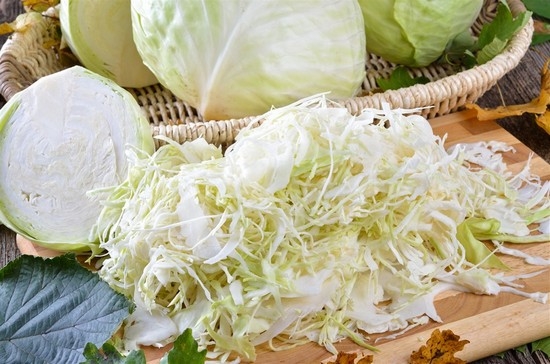
The taste of a dish is influenced not only by your actions in the process, but also by the choice of the product. Professionals assure that if the cabbage was initially very bitter, fermentation will not change its properties, and it will remain just as bitter. So be sure to taste the leaf before mixing it with the rest of the ingredients. It is best to choose varieties with a white leaf that does not have large veins.
What else to remember:
But not everyone knows how to cook it, although this business is not tricky. Some complain that the cabbage is soft, not crispy. Someone advises that sauerkraut crunches, do not knead it with your hands, someone recommends adding a little sugar, someone thinks that cabbage will crunch if you add horseradish.
I will not refute anything, only here I have sauerkraut always comes out juicy and crispy. This is how my mother taught me to ferment cabbage, and she was an excellent housewife and knew a lot about pickles and jams, since she was from the village. I will share with you some of the subtleties of simple sauerkraut for the winter.
With the seeming simplicity of the recipe, there are some subtleties that are very important to observe in order to get delicious sauerkraut. If you know and follow a few rules for fermenting cabbage, then success will be guaranteed.
The first rule: you need to ferment cabbage only from a fresh crop and mid- or late-ripening varieties. It is these varieties of cabbage that contain a lot of sugar and are therefore very juicy. Heads of cabbage should be firm, not loose and white, not Green colour. And of course, slightly frozen heads of cabbage are not suitable for sauerkraut.
The second rule: you need to observe the proportion of salt relative to the weight of already shredded cabbage. For 1 kg of chopped cabbage, you need to take 25 g of salt, no more and no less.
The third rule: for 1 kg of shredded cabbage, you need to take approximately 20-30 g of grated carrots. Here, great accuracy is not required, you can be guided by your own taste. Carrots give sauerkraut a beautiful look and enhance the taste.
And finally, the fourth, most important rule: Cabbage fermentation should take place at a temperature not exceeding 18 degrees, that is, not in a room, but in a cooler place. A loggia is ideal for this. In autumn it is no longer warm there, but not cold either. If you leave the cabbage to ferment in a room with a temperature of 20-23 degrees, then the cabbage will not turn out crispy.
From one large head of cabbage weighing about four kilograms, I got three and a half liters of sauerkraut. Since the cabbage is packed very tightly into the jars, the weight of the cabbage is much more than 3.5 kg.
Ingredients:
Cabbage - 1 head (weight about 4 kg)
Salt - 100 g (remember the proportion)
Carrots - 13 pcs. (weight of shredded carrots is approximately 120 g)
Dill seeds - 1 tbsp. l.
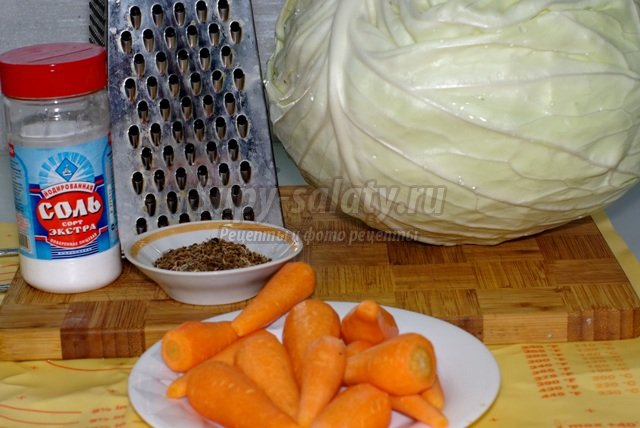
Prepare a head of cabbage. Remove the top leaves from the head, strip it to white leaves.
Get a large pot or bowl ready. Line the bottom of the pot with cabbage leaves.
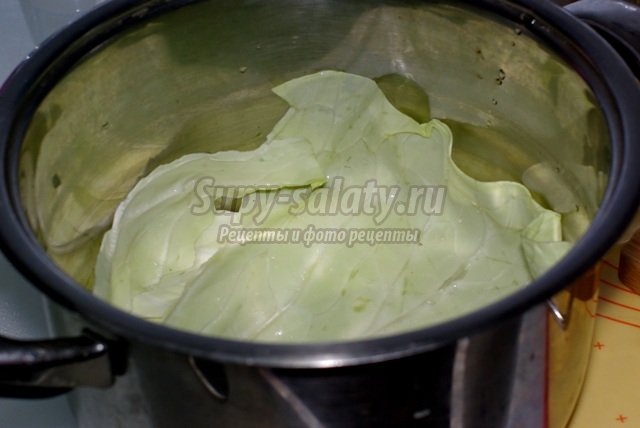
Cut the head of cabbage into several large pieces, so it will be more convenient for you to chop the cabbage. Make sure that the knife is large, comfortable and sharp. Start shredding the cabbage finely.
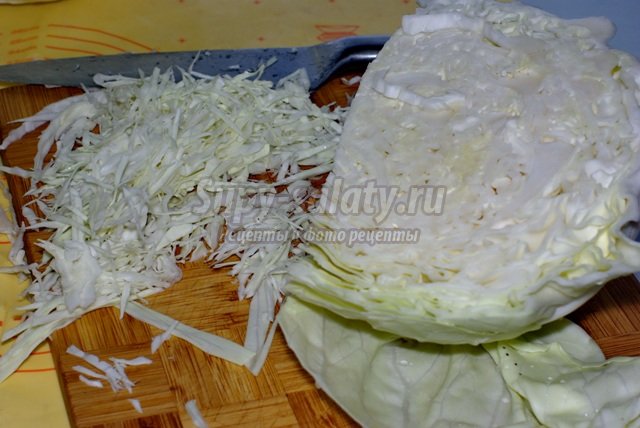
Gradually chop the entire head of cabbage, and discard the stalk. Previously, we always ate the remaining cabbage stalk, but now it is believed that this should not be done, since harmful substances allegedly accumulate in it. So decide for yourself what to do with the stump, eat it or throw it away.
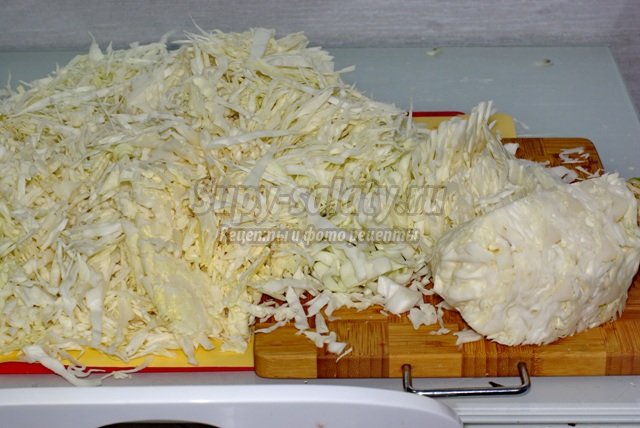
Grate carrots on a coarse grater.
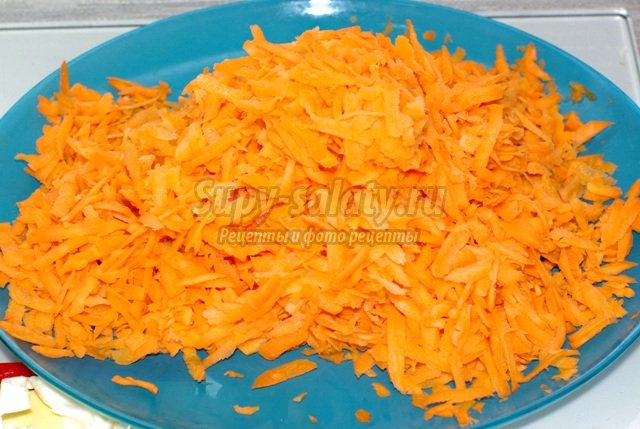
Sprinkle the cabbage with salt. Stir the cabbage so that the salt is evenly distributed. Knead the cabbage with your hands, as if you were kneading dough. From this procedure, cabbage will give juice.
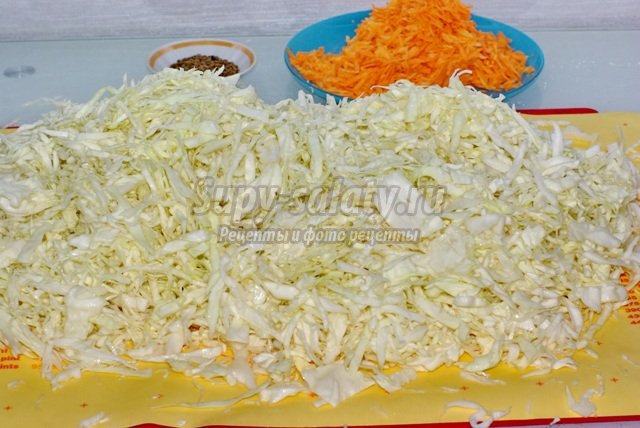
Sprinkle the cabbage with dill seeds and grated carrots.
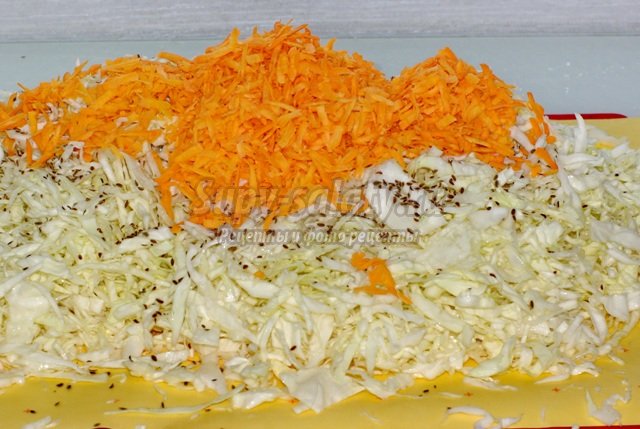
Now do not wrinkle the cabbage, but only mix it with light movements so that the carrots and dill evenly mix with the cabbage.
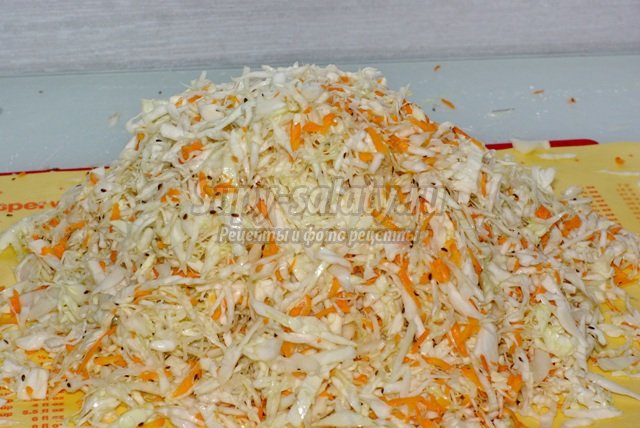
You have already done the main work. The sauerkraut is ready. Place the cabbage in the pan very tightly, literally tamping it with two fists. For this operation, I resort to the help of my husband, since I do not have enough for this. When the cabbage is tightly packed, there will be a lot of cabbage juice on the surface.
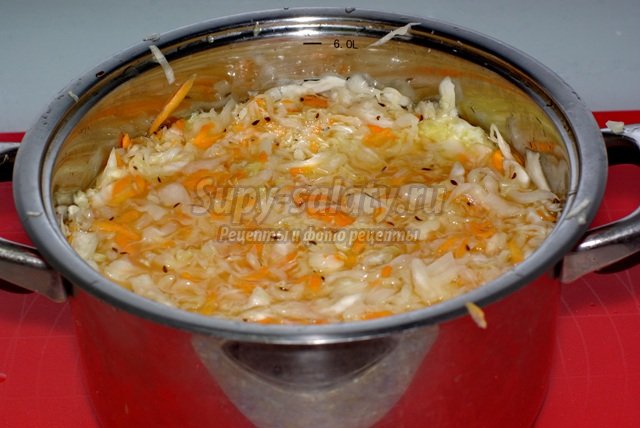
Place a flat plate on top and place a weight. I used a three-liter jar of water as a load.
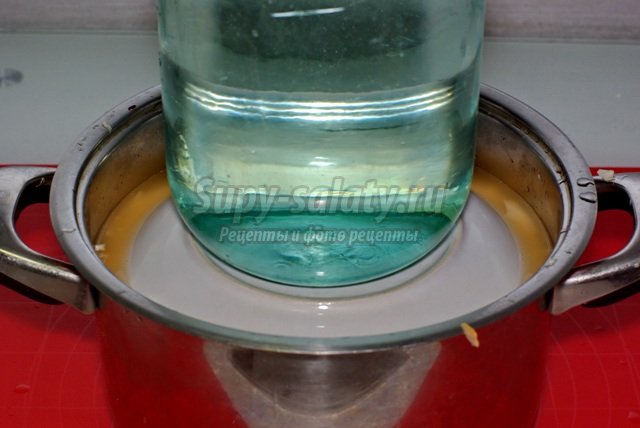
Take the cabbage to the loggia for fermentation. During fermentation, foam will appear on the surface of the cabbage, which will need to be removed. When the brine becomes light and sour-salty, and not bitter in taste, we can assume that the release of gases has stopped and fermentation has ended. This will happen around the eighth day. You can try the cabbage and decide whether to hold it for another day - another under oppression or it is already completely ready and can be transferred to jars. I do not like to ferment cabbage, so on the eighth day I always put it in jars. Remove the oppression, do not drain the brine from above. Take a spoon and carefully spoon the sauerkraut into the jars. Place the cabbage in jars as tightly as you put it for fermentation. But not with your fists, of course, tamp. In this case, it is enough to press it with a spoon. The main thing is that the cabbage is constantly under the brine.
How to ferment cabbage for the winter? - a question that interests many hostesses. There are many recipes that will help you cook delicious cabbage, just remember that the cooking process will take more than one day. And in the conditions of an apartment, it is not as easy to do this as in a private house.
Cabbage is considered one of the healthiest vegetables, which contains a huge number of different vitamins. Thanks to cabbage, many diseases and minor health problems are treated. you can talk for hours without stopping. It can be consumed as fresh, just rinse it well, or pickled. And in fact, and in another version, it turns out very tasty and healthy. Today we will talk about the benefits and methods of cooking sauerkraut. It is difficult to name a person who would say that he does not like such cabbage. There are few such people. Therefore, if you ferment cabbage, you can please almost everyone. Sauerkraut is also suitable for a family dinner, you can easily offer it to the festive table, as one of the types of salad, while it is enough just to decorate it beautifully. In a word, well-sauerkraut is not only a storehouse of vitamins, but also very tasty snack.
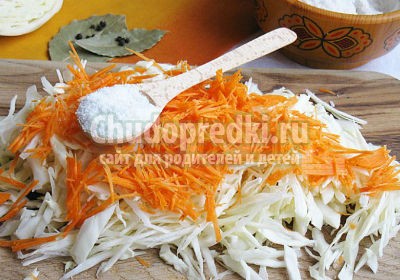
Sauerkraut recipe for the winter involves cooking in barrels and jars. You can also find recipes that describe methods for preserving cabbage, only in this case, vitamins are not preserved in the amount in which they can be obtained by fermenting a chopped vegetable. There is a certain set of rules that must be observed, despite the recipe you choose.
Let's start with what will turn out really tasty if you choose only late varieties of this vegetable, while the heads of cabbage should be white, ripened. The fact is that in such heads of cabbage there is a large number of sugar, which we desperately need for our further fermentation process. That is, the more sugar in the composition, the better the final result will be.
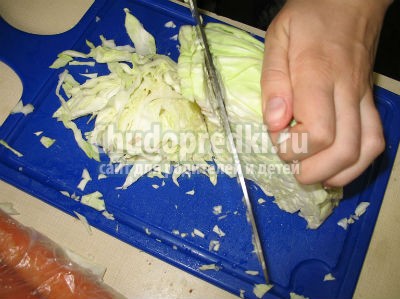
The second point that should be observed when fermenting cabbage is that you do not need to wash the vegetable before shredding! Your task is only to remove the polluted or black places, and remove the green leaves. And shredding is worth a certain way. This will avoid the rough parts. So, let's start with the fact that the cabbage is initially divided into two or four parts from the stump, which will need to be cut out. After that, you can start shredding. We produce it across the veins, while the strips should average about three millimeters.
Kvasim cabbage for the winter (recipe) in such a way that it was cut into larger pieces. This will allow you to preserve the beneficial substances that it contains to the maximum. Some people, by virtue of this judgment, pickle cabbage whole heads or cut them in two. A good option, but not suitable for everyone.
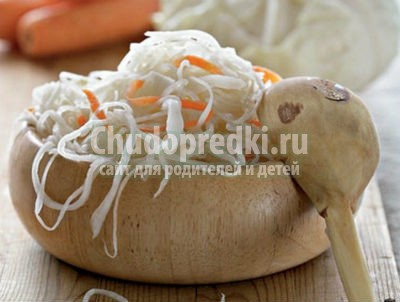
How to carry out the fermentation itself? For this procedure, it is better to choose enamel pan, it is desirable to take a fairly wide one. Sourdough, as you understand, will take place in the process of fermentation, which can be achieved when the cabbage is in contact with air. That is, the greater the contact, the faster and more thoroughly the leaven will pass. And you will see the fermentation process itself when foam begins to form on the surface of the cabbage. By the way, it must be removed on a regular basis. At least once a day.
During the fermentation process, cabbage can release gases, therefore, so that they do not stagnate, stir it periodically or simply pierce it in several places with a wooden appliance. If you forget about this procedure, your cabbage will give off unpleasant bitterness. Be careful not to skip this step while cooking.
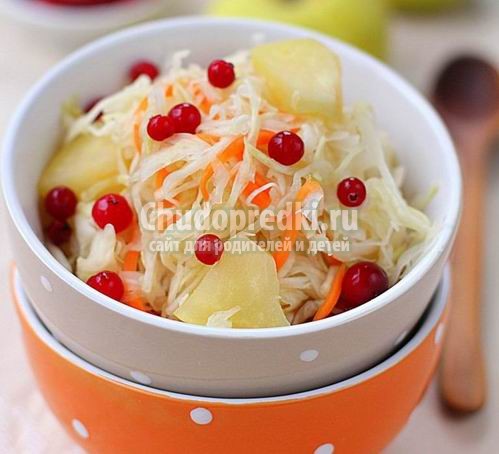
Remember to keep your sauerkraut covered with brine at all times. If the cabbage is fresh and ripe, it will release as much juice as it needs for pickling. If there is not enough brine, make it yourself and fill your cabbage. It's easy to make. Enough for one liter of water, previously boiled, put a tablespoon of salt.
We have listed the main rules for making sauerkraut. In addition to them, there are several other popular beliefs that also do not hurt to know. In the first sign, we are talking about the fact that sourdough should only be started on that week, in the name of which the letter “r” appears. It is on such a day, having started cooking, it will turn out delicious cabbage. And if you want to have crispy sauerkraut for the winter, then start preparing it for the growing moon. Cabbage will turn out not only crispy, but also moderately sour, juicy.
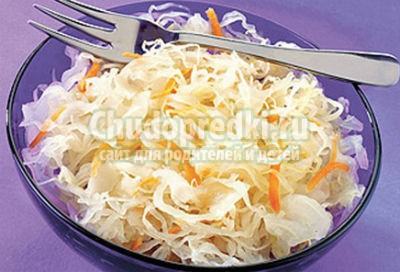
We discussed the necessary points, now you can safely proceed to the cooking process itself. every hostess should know, because such a delicious snack will delight every guest and family member. And if you also immediately ferment a lot of cabbage, then for a long time you will not have to think about what to serve on the table.
Sauerkraut is good for its taste, so it is often used as a separate ingredient for more dishes. For example, in our country, hostesses prefer to make vinaigrette with sauerkraut. Of course, you can do without it, but the taste of the salad will be lost. They turn out very tasty and. Shchi, like vinaigrette, is cooked in different ways, sometimes with fresh cabbage, sometimes with sorrel, sometimes with sauerkraut. In each version, the taste of the soup is specific. And it’s impossible to say which option is tastier. After all, each family should choose for themselves the one that is more to their liking.
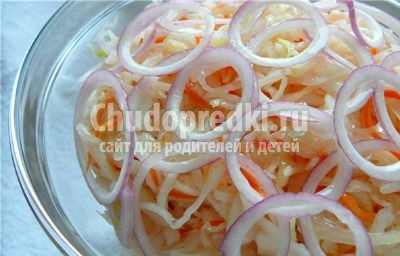
So, let's look at several ways to cook. Let's start with the simplest and fastest way that everyone can handle. Of the ingredients, we need three to four kilograms of cabbage, half a kilogram of carrots and half a glass of sugar. For additional preparation of brine, take a liter of water and a spoonful of salt. As expected, for any cabbage, we chop it according to the method described above. Grate the carrots and mix them together. We knead well with our hands so that the vegetables become softer and the cabbage gives as much juice as possible. After that, we put them in jars, and they need to be tamped very tightly. Pour the prepared brine on top and rewind the neck of the jar with gauze. The preparation process is almost over. We need to shift more of our cans into a basin. This is necessary so that during the fermentation process the brine does not spill over the floor. After two or three days, drain all the juice from the cans. Add sugar to it, mix well and pour back into jars. After four to five hours, the cabbage will be finally ready, and it can be served on the table. Store cooked cabbage in the refrigerator. Such delicious sauerkraut for the winter suitable for cooking at home in the apartment. Everything is easy and simple, no difficulties should arise in the process. Even a teenager can cope with the task of cooking.
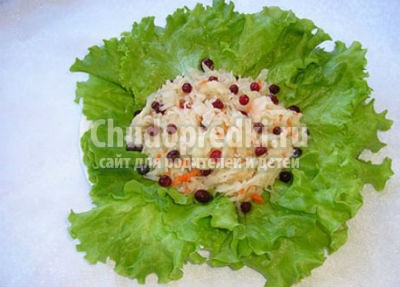
We would like to tell you about the original method of preparation. For this, we need about ten kilograms of cabbage, half a kilogram of carrots, water, salt, sugar, garlic and hot peppers. In addition, you can use parsley or celery, as well as cumin or dill seeds, depending on personal taste preferences. Let's move on to cooking. You don't need to shred the cabbage for this recipe. It is cut into fairly large pieces, the stalk is removed, and laid out in a special container for fermentation. Pour brine on top. Now we just have to crush it with oppression and leave it for four to five days to ferment. At the end of the term, the cabbage is taken out, chopped, grated carrots, cumin or dill, hot peppers and chopped garlic are added to it. If desired, add to the cabbage and greens. Drain the brine from the cabbage, filter it well and put it on the fire. Bring to a boil, cool it and pour it again to the cabbage. We re-cover the entire resulting composition with oppression and leave for another couple of days. Add sugar, mix well and put our cabbage in jars. It is best to store cabbage in the refrigerator or in another cold place.
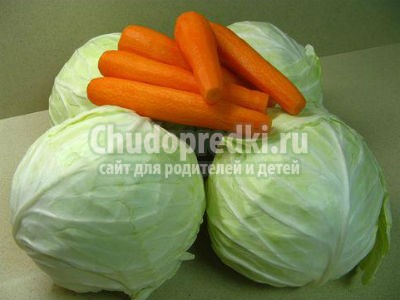
Harvesting sauerkraut for the winter it will turn out very tasty if you ferment it with sugar and vodka. It seems that vodka will add bitterness to the cabbage. And the very combination of cabbage and alcohol leaves much to be desired. But all this is just speculation. In fact, the taste is amazing. We take sauerkraut already prepared in the usual way, drain excess brine from it and transfer it to jars, tamping tightly. Pour two tablespoons of vodka on top, and three tablespoons of sugar. We roll each jar with a metal lid and leave it to be stored in a warm room.
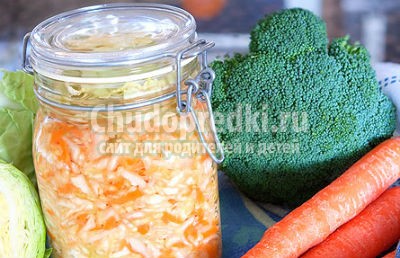
We have described only the most popular ways to cook sauerkraut. There are many more options: dessert, with pickles and so on. Sauerkraut is not only tasty, but also healthy. For example, sauerkraut for the winter (photo) cleanses the entire body, removes all the muck from the liver and the entire gastrointestinal tract. In addition, cabbage helps burn fat, and generally prevents its appearance. Many nutritionists even offer a special cabbage diet, which even celebrities adhere to.

The most interesting thing is that even fresh cabbage not as useful as pickled. You probably didn't know about it. And beneficial features persist only for the first ten months, after which it is better to cook a new cabbage. The most valuable vitamin in sauerkraut is vitamin C, which will help maintain immunity and prevent inflammatory and infectious diseases. Try to eat sauerkraut especially regularly during the cold season.

Please note that such cabbage has its own contraindications. For example, those who have visible problems with the duodenum, have a stomach ulcer or gastritis, it is better to refuse to eat cabbage. It can cause heartburn, bad breath, boils, and so on. There may also be swelling. So be careful with sauerkraut. Just eat it little by little during winter period. After all, it is so difficult to completely refuse goodies.
If you like our site, express your "thank you"
by clicking the buttons below.
This vegetable is harvested in different ways. As a rule, some of the heads of cabbage are stored fresh (), and the rest of the cabbage is fermented for the winter. The most common way is in banks, since not everyone has a cellar, and if there is one, then it is not always possible to place a larger container (for example, a barrel) in it.
It is recommended to ferment cabbage in jars, which has a sweetish aftertaste. Such heads of cabbage differ in white, only the leaves of the upper row can be with a greenish tint (for example, Michurinskaya, Slava). And yes, it doesn't hurt to taste it. If bitterness is felt, then it will remain so, and it is unlikely that it will be possible to level it.
Forks must be tested for density. Compliance under compression is a sign of a loose structure. Such cabbage, if fermented, is for the short term.
An important component of a competent choice of a head of cabbage is an external examination. Small cracks, scuffs on the upper leaves are allowed, but darkened areas are not. As a rule, this is one of the signs of the development of punctate necrosis. In addition, if the shell of the fork is wet, then the head of cabbage, most likely, has already begun to deteriorate from the inside.
In most articles on the topic of sauerkraut for the winter, it is noted that for this it is best to take late-ripening varieties, and the author entirely agrees with this. Until spring, they retain their juiciness even when fresh and are pleasantly crunchy.
The calculation of cabbage consumption is simple - for a jar with a capacity of 3 liters, one fork weighing about 3 kg is enough. After shredding, it completely fits in this volume.
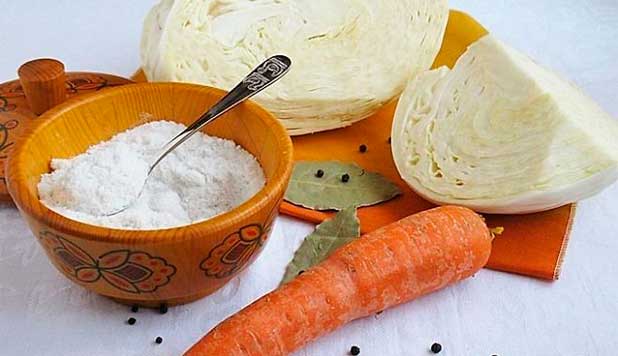
You need to be careful with salt. Firstly, only non-iodized, otherwise the cabbage will lose some of its taste. Secondly, salt should not be abused, since fermentation and salting are completely different things. The approximate consumption per 1 kg of loaded mass (cabbage + carrots) is within 25 ± 5 g. It is not difficult to change the proportion, but this is already at the discretion of the “consumers”, that is, family members. It's never too late to add salt to sauerkraut.
Carrots give cabbage a sweetish flavor. This must be taken into account when determining its consumption. On average, a ratio of 1 to 10 is practiced. But if cabbage is fermented, for example, white cabbage, which “sweetens” a little, then the proportion of carrots, as you might guess, decreases. An increase is possible only with some cooking options, when a large number of other ingredients are used - cranberries, peppers, beets, apples, and so on.
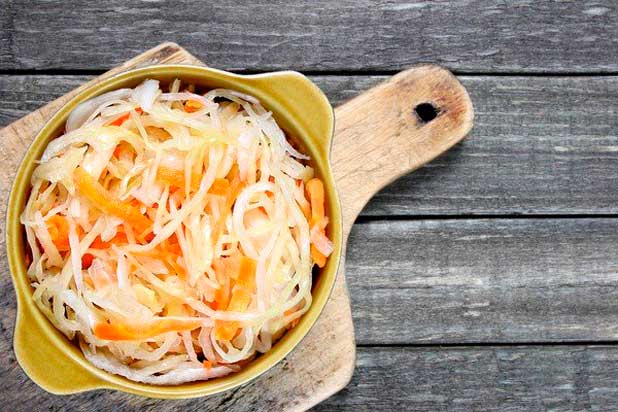
There are many different recipes on the Internet. What should not be forgotten? Firstly, the preparation of any food is a creative matter, and every housewife, no matter what the discussion is about, will always say that she has her own special secret. Secondly, all people differ from each other, including taste preferences and sensations. If one dish praises, then this does not mean that the second will not be completely indifferent, and the third will not give the most negative feedback. That is why it is necessary to consider the proportions of ingredients below as approximate (for forks 2.5 - 3 kg). Having prepared sauerkraut in this way for the first time, it will immediately become clear (taking into account the opinions of all family members) what should be adjusted to your taste.
The fact that all vegetable ingredients that are used must be peeled and washed thoroughly is an axiom, so it makes no sense to specify this separately for each recipe. But heads of cabbage are enough just to get rid of the top sheets. You don't need to wash them afterwards.
Any components, especially spices, that are used in the process of cooking sauerkraut interrupt its natural taste. Since all recommendations on their ratio are purely indicative, having decided to test a new recipe, it is advisable for the hostess to take a small amount of products and make a trial starter. It takes a little time for fermentation, so after five days it will be possible to assess its quality and decide whether it is worth harvesting all the cabbage for the winter in this way, and if so, whether something needs to be corrected (increase the share, reduce) or not.
What you need:
Technology of sauerkraut:
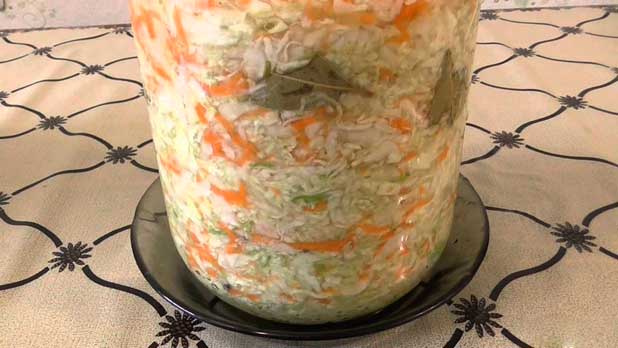
And so - levels, until the bank is full. Lavrushka is placed in containers between layers, evenly along its height. The neck is tightly covered (with a plate, a piece of glass, and so on), and a load is placed on top. This is necessary to ensure the fermentation process of cabbage.
Depending on the conditions in the room (primarily temperature), after about 24 hours, bubbles will begin to accumulate around the neck of the jar. They need to be removed regularly, as this can take up to five days. It is necessary not only to remove the makeshift cover, but also to pierce (to the full depth, repeatedly) the loaded mass. When the reaction is complete, we can assume that sauerkraut is ready. The bank with it is stored in some cool place - a “winter refrigerator” (under the windowsill in the kitchen), in the cellar or basement (if it is a private house).
What you need:
Pickling technology:
At room temperature, the fermentation process lasts about 2 days. As soon as gas formation stops, the jar is covered with a lid and put away for storage. This method of pickling suggests some versatility in the use of cabbage. Before use, it can be seasoned with onion, vegetable oil, mixed with cucumber slices (pickled or pickled), add a little sugar - it all depends on the taste preferences of the household.
What you need:
Pickling technology:
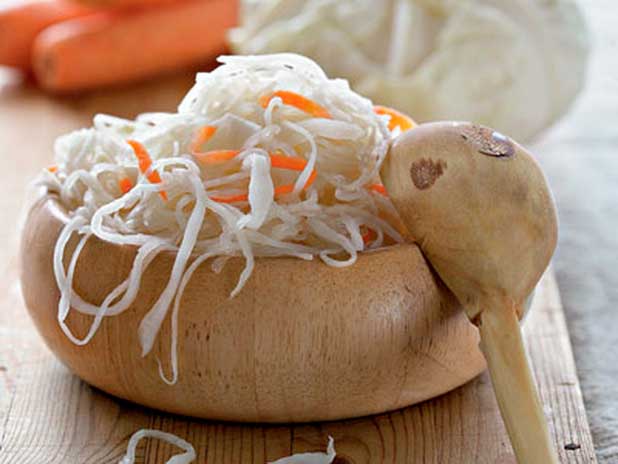
According to this technique, with alternating layers, the jar is completely filled (about 5 cm is left before the neck cut). Everything else - sealing the container, periodically removing gases from it, organizing storage - is similar to the first fermentation method.
What you need:
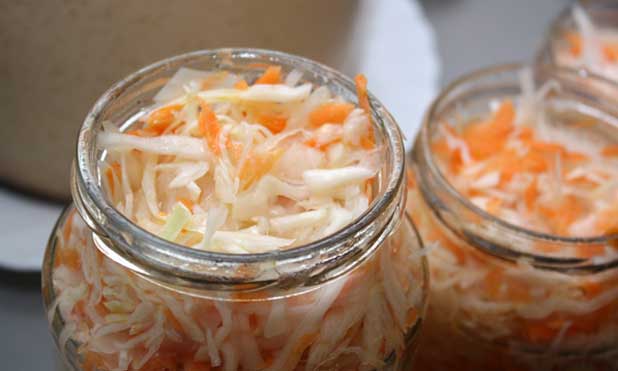
Pickling technology:
With this method, sauerkraut can be eaten after 4 hours.
Mixing cabbage with other vegetables, grinding the prepared mass is more convenient to do in a basin of the appropriate capacity, but not metal. If it is enameled, then there should be no chips on the coating. A large pot is not the best option for fermentation. To speed up this process, it is necessary to ensure the largest possible area of contact of the product with air, so cooking in a basin according to some recipes is still better.
It is necessary to carefully monitor the intensity of gas formation during the fermentation of cabbage. If the bubbles are not removed in time, the final product will acquire a bitter taste. The same applies to foam, which regularly appears on the surface.
Cabbage should be shredded not along, but across the veins. This results in smaller strips that are easier to grind until juice appears. But here too, moderation must be observed. The smaller the slice, the worse useful substances are stored in it. That is why fermentation with whole forks, in barrels, is considered the best option.
A jar of cabbage in the process of its preparation must be placed in a small bowl or a large plate, since fermentation is accompanied by pouring out the solution from the container. That is why it is not recommended to fill it with the top, along the cut of the neck.
Those who are guided lunar calendar, it is useful to recall that it is better to engage in sauerkraut during the growth of the “night Goddess”. And whoever believes in omens, keep in mind that Monday, Friday and Saturday were considered by our ancestors to be unfavorable days for this work.
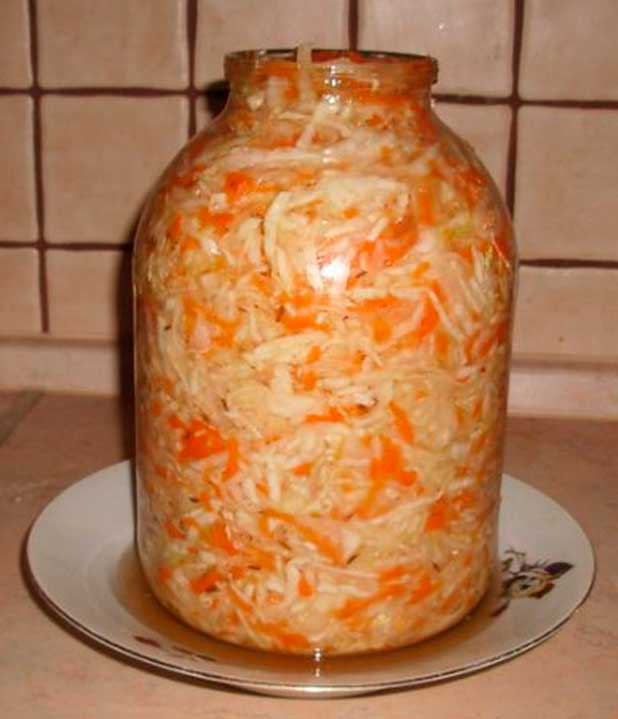
The article shows only a part of all available recipes. But, judging by the reviews, most summer residents sour cabbage in exactly one of these ways. Try it, you might like them.
And yet it's not the number of recipes that the hostess knows. Cooking the same thing, one cabbage turns out completely different from the other. The point is precisely in the specifics of preparation, since any discussion of fermentation methods boils down mainly to clarifying various trifles. You can only achieve the desired taste with practice, so do not be afraid to experiment. The author once again emphasizes that all share ratios for any of the recipes are purely indicative.
Juicy, crispy and with a pleasant sourness of cabbage for the winter to you, dear reader!